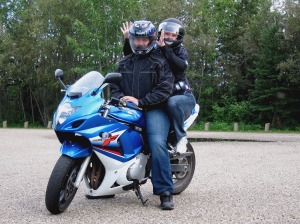 Originally published in the Aug. 31 issue of the Mile Zero News. This one’s for Grandpa.
Originally published in the Aug. 31 issue of the Mile Zero News. This one’s for Grandpa.
Two weeks ago a very exciting package arrived at the office via Purolator. Quite normally I receive small packages from my family in Ontario at the office, but this box was quite a bit larger and so I knew it could only be one thing – my new bike gear. For people who know me well, I’m not sure they’d be able to picture me in a motorcycle jacket, helmet and gloves ready to hop on a street bike. However, in getting to know a whole new group of people as well as their hobbies, I’ve been encouraged to try something new.
Until last week I had only ever rode as a passenger on a motorcycle on my grandpa’s cruiser. Growing up with a motorcycle-riding grandpa meant that when grandpa showed up on his bike, we would take special trips to the coffee shop for a donut (that we weren’t allowed to tell grandma about). During our ride to the coffee shop, we could also expect to listen to classical or gospel music through the sound system hooked up through our helmets.
After last week’s ride on this friend’s bike, all I have to say is riding on grandpa’s bike is an experience worlds apart from riding as the passenger on a street bike. My grandpa’s bike has a sheep-skin padded seat with arm rests that I can comfortably ride in. The street bike required me to get as low as possible, have my legs propped up on the pegs, and position my head in just the right spot in order to avoid wind turbulence between my helmet and the driver’s helmet.
While riding with grandpa, we would cruise around the back roads, check out the scenic areas he grew up in, and carry a conversation through our miked helmets. Riding on the street bike meant I needed to be prepared for the bike to keep accelerating and concentrate on moving with the bike – not leaning too far one way or the other and remaining perfectly still. Conversation is also out of the picture, unless you count the way I squeezed my driver’s side in a slightly nervous way. My life was in his hands and there was nothing I could do but trust that we would make it back to our doorsteps without a scratch.
Don’t get me wrong, riding on the street bike was a lot of fun and now that I have most of my gear, I hope to get on the bike a few more times – before the weather gets much colder.


